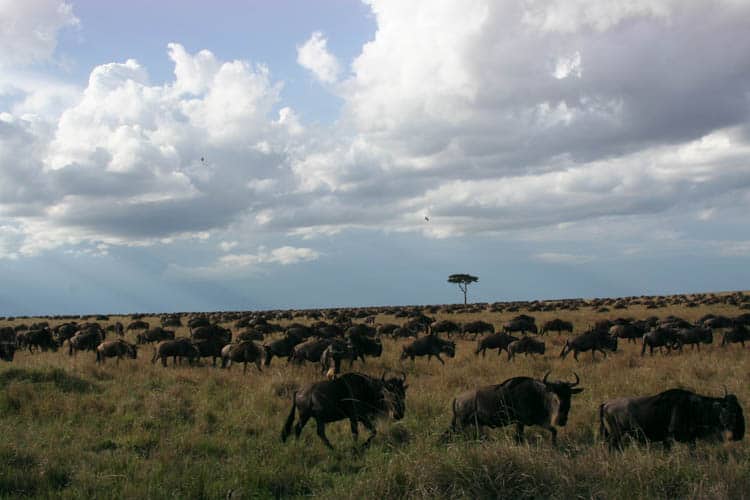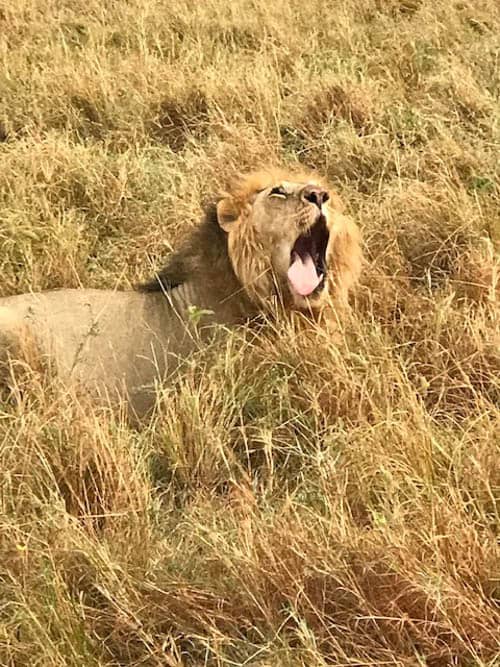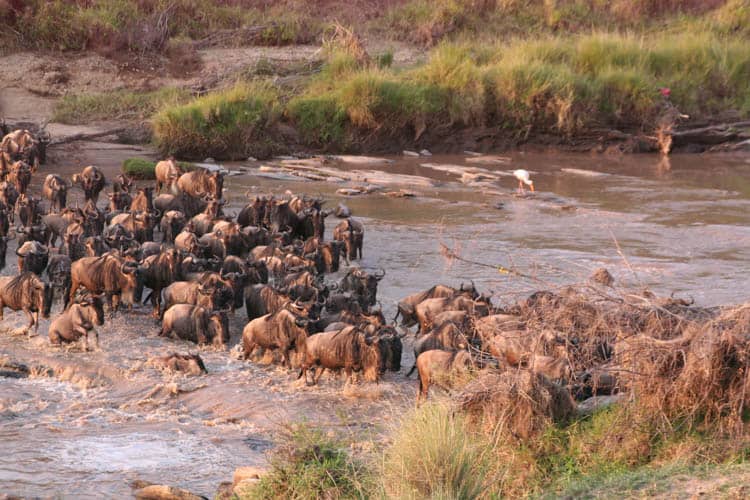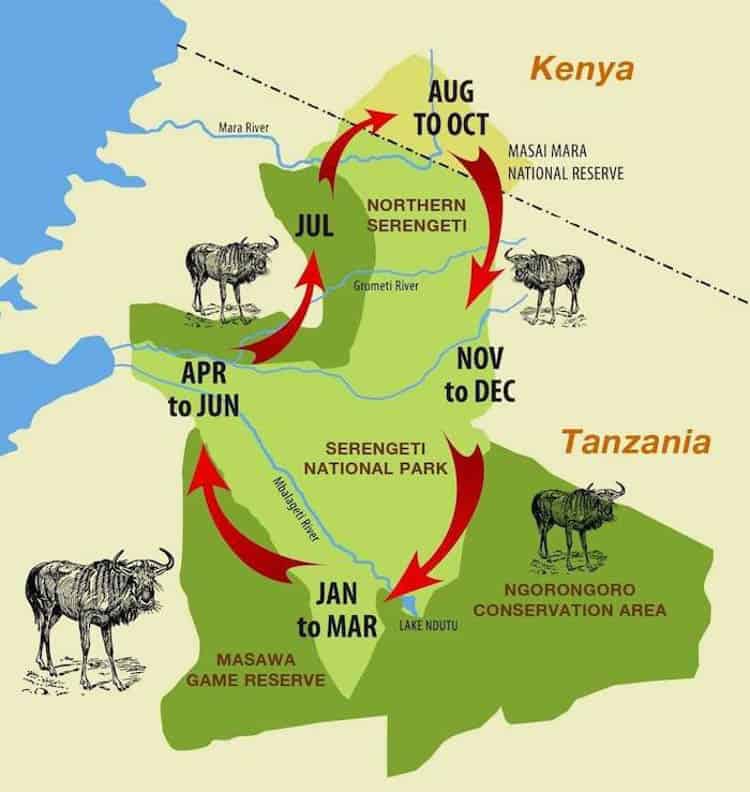
The plains trembled and the swirling, brown cloud of dust hovered as the wildebeest moved towards the Mara River. The Great Wildebeest Migration across the plains of East Africa had begun.
The migration is one of the world’s most spectacular displays of wildlife behavior. Nowhere is there a terrestrial movement of animals as immense as the wildebeest migration. It is a thrilling, intriguing and marvelous sight.

The Wildebeest Migration Begins With a Trickle
At first, it is just a trickle. An advance guard of zebras and a few columns of wildebeest. They cross the Tanzanian border and spill onto the savannah plains of the Masai Mara National Reserve. The reserve which is in Kenya forms part of the continuous ecosystem with the Serengeti National Park in Tanzania.
The trickle soon becomes a flood as the main body of the migrating herds comes rumbling in. For the next three to four months, usually between July and October, they stay in the Mara enjoying the fresh green pastures.
They remain until the arrival of the short rains sometime in October or November. Then, Tanzania draws them south once again.
As the masses of wildebeest move towards the river and gather on the banks, their urgency and hesitation can be sensed. The energy in the air crackles with anticipation and is gripping.
Watching them, the wildebeest seemed to be mustering courage, as not even they appeared to know when to cross. It is impossible to predict. Some arrive at the water and swim over immediately while others spend days grazing. Still others turn back to where they have come from.
Unfortunately, the spectacle of the migration is misunderstood by many visitors which can lead to disappointment. It is not a mass of rushing herds as often seen on TV and in documentaries. Most of the time the wildebeest spend time grazing and gradually moving forward towards the numerous water crossings.
It takes time and patience to see them lining up in columns. Plus, luck to be at the right place at the right time when they decide to cross.

Covid’s Effect on Tourism in Masai Mara Kenya
The Masai people named the vast plains the Mara as it means “spotted land” in the Maa language. It was a reference to the acacia glades that once freckled the grasslands before fire and elephants created today’s open vistas. The Masai Mara is the land of the Masai people. It is not a national park but rather a national reserve belonging to the Masai people.
Each year the wildebeest migration sparks a twin migration. First, the almost two million animals themselves. Plus, tourists from around the world who flock to Kenya hoping to witness the natural wonder.
This season has been anything but typical. The reserve, which was established in 1961, has been depleted of international visitors. The blow to Kenya’s economy has been devastating.
Last year about 1 million tourists visited the Mara, mainly from the USA, Europe and China. This provided much-needed income to the Masai community especially the informal sector that depends on tourists purchasing souvenirs.
Normally the plains would have been busy with game viewing vehicles full of visitors hoping to see a crossing. But this year Kenyans had one of the country’s most sought-after wildlife experiences to themselves.
Tourism has struggled worldwide due to travel restrictions. Kenya is no different as its international borders have been closed at times. This was a disastrous time for the lodges and tour companies.
If you’d like to travel to see Maasai Mara without contributing to the mass-tourism, consider traveling as a volunteer on the Tanzania Community Volunteer trip. Teach women’s empowerment or help improve child education during your stay and strengthen the community while exploring the natural majesty in Africa. Find out more about how you can be a part of this important volunteer trip here.

Pivoting to an Untapped Market
Sadly, some simply closed. But, the more innovative ones recognised they had an untapped domestic market that had, possibly, been neglected during past migrations.
By adjusting what they offered to satisfy the different expectations and needs of the local market many Kenyan residents were able to witness the migration for possibly the first time. This allowed businesses to survive with many camps being fully booked for the migration period.
I had not visited the Mara for many years as I had previously found the experience disappointing and distressing. Having visited many national parks in Kenya and other African countries I found the frenzy of tourists rushing around in safari vehicles, jockeying for prime positions at the river-crossing sites irritating.
That, combined with the harassment of predators, especially the cheetahs, showing little concern for the animals they came to see and ignoring the basic rules of the bush was all too harrowing to tolerate.

It was refreshing and a privilege to experience the Mara once again as a peaceful wilderness. Especially, to see that the reserve management was enforcing their rules and penalising defaulters.
The reserve was closed for many months. In that time Mother Nature was able to heal a little. The animals seemed more relaxed and many dirt tracks were now covered with grass erasing the scars of the previous tourist season.
Without the pressure of other vehicles, I was able to sit watching a serval stalk and kill a large rat before taking it to its lair. Lions were plentiful and sightings of cheetah strolling across the grasslands as well as leopard investigating a riverbank were delightful moments.
With fewer vehicles around I reveled in the random and at times chaotic activity of the wildebeest and was fortunate to share the experience of three, action-packed, river crossings with only two other vehicles. Whereas in past years there could have been up to one hundred.
The Reserve has about 230 lodges and tented camps. This gives an indication of how many visitors the Mara can accommodate during the height of the migration season. During this last season, just a handful were open, mostly due to the Covid restrictions as well as the lack of international tourists.

River Crossings of the Wildebeest Migration
The Mara River meanders for 360 km and the animals can cross anywhere. So, although there are some well-known places, there is not a single crossing point and there are no guaranteed places to witness the dangerous and frenzied river crossings.
During the migration, there are numerous daily crossings over the Talek and Mara Rivers. One of the misconceptions of the migration is that the crossings can be predicted and are always at set river points. There are just a few individuals at some places, while others see a mass of animals moving without a break for hours.
Waiting at the water’s edge I felt excited but also anxious as I knew that the time frame for the animals taking the plunge into the water would always be critical. Along with the snapping jaws of the crocodiles, there is also the ferocious current of the Mara River which often ends more lives than the predators.
Large numbers of wildebeests drown during the crossings and their bodies provide a feast for the vultures and marabou storks. The crossings are by far the most dangerous part of the entire migration journey.
Suddenly, I saw thousands of wildebeest line up and move hastily across the plains towards the river. Then the chaos of the crossing began. I was in awe of and relieved for the strongest and most determined animals who reached the other side. Having survived the crossing some crossed back again in search of their young ones who perhaps had not joined the group or were too nervous to cross.
The atmosphere was one of amazement, excitement and encouragement as I watched the drama of the wildebeest leaping into the river. They almost bounced across the water, noisy, energetic, frantic, panic-ridden and chaotic.
They were like ants, seemingly milling around with no direction but with an instinctive objective and most with enough adrenaline-driven energy to get across.
But, this scene also brought sadness as some animals were swept away by the river current and became wedged in the rocks and mud. We knew that there was nothing that could save them.
These exciting, violent and dramatic crossings have been captured in many excellent films and documentaries. However, being there and witnessing it from the river’s edge was an emotional and unforgettable experience.
Not everyone visiting the Mara is fortunate enough to witness a river crossing. Others who have been there, never want to do so again because of the chaos and the trauma that accompanies the event that causes a massive loss of life. Some river crossings are just a few individuals while others see a mass of animals without break for hours.
By late September, the main mayhem has ended and the migrating columns gradually move eastwards in the Mara. However, the wildebeest must face the river crossings once again for their journey southwards to the Serengeti.

The Mysteries of the Wildebeest Migration
The migration occurs within an area that is known as the Serengeti ecosystem. It is not a single isolated event. Instead, the phrase describes the constant movement of over 1.5 million wildebeest. In addition, there are hundreds of thousands of zebra and smaller numbers of antelope such as eland, topi, impala, Grant’s and Thompson’s gazelle.
The noisy, grunting army, chomp and trample the grass and rush across the Mara River in search of fresh grazing. In doing so they provide predators with a season of plenty until the rain in October and November draws them south to Tanzania again.
The Mara is the most northerly portion of the migration route and is the acclaimed location for the wildebeest migration due to its famed Mara River crossings. It has been named as one of UNESCO’s Wonders of the World and is one of the most sought-after experiences for wildlife and nature enthusiasts.
This has led to some misunderstandings about the migration. It is an ever-moving column of animals following an age-old route that takes place throughout the year. The purpose of the movement is the search for pasture and water. As vital resources are depleted in one area the animals move on to the next. Along the way there is drama as animals are taken by predators but thousands more are born sustaining the circle of life.
“When will the migration begin?“ Each year this question is asked at every lodge in the Mara. No one knows exactly when but by July the “answer” is already tramping across the plains. Hundreds of thousands of hoofed animals come together and cross the Serengeti towards the new grass of the Mara.
The precise timing of the Serengeti wildebeest migration is entirely dependent upon rainfall patterns each year. It is unclear how the wildebeest know when or where to go. But, it is generally believed that their journey is dictated by weather. There is no way to predict exactly where the animals will be at any given time during their journey.
What triggers them to muster the energy to begin a 1,000 km round trip through two countries? A trip across plains with lions and leopards waiting for them plus treacherous river crossings with crocodiles.
Around 250,000 wildebeest die along the way, lost to predators, disease and fatigue. Starvation and thirst are even an issue despite plentiful food on the rolling plains of the Serengeti.
Somehow, a few seem to sense it’s time. Perhaps there is something in the air. Just like that they get up and go and the largest terrestrial migration of animals on earth begins. Why, when most wildebeest in Africa are non-migratory do the animals in the Mara-Serengeti ecosystem risk so much in one mad trip?
It remains a mystery largely, but some scientists believe it is to do with the chemistry of the grass. The grass responds to the rain with higher levels of phosphorous, calcium and nitrogen. This attracts the wildebeest.
Perhaps the animals are just following their taste. It could also possibly be instinct. For eons the wildebeest have been following this route across the plains of East Africa.

Migration Calendar
Although there is no beginning or end to the migratory circuit, it seems reasonable to call the birthing season, around the end of January/early February, the start of the migration. In mid-March, the mothers have calved and thousands appear milling around the rolling plains of the Serengeti. With the abundance of vulnerable young calves, it also means that predators are numerous and hunting is easy.
During April, the herds begin to drift northwest towards the fresher grass of the central Serengeti, bringing thousands of zebra and smaller antelope with them. By May the columns of wildebeest stretch up to 40 km. The mating season begins towards the end of the month, with the males battling head-to-head during “the rut.”
Throughout this time the journey continues at a leisurely pace with the wildebeest, zebra and gazelles grazing as they go along. In June, the dry season usually begins. By July they have been trekking across the plains for 3 months. But, still they have the final hurdle of the rivers to confront.
At the end of August, most of the animals have faced the challenge of the Mara River crossing. It is now time to enjoy the nutrient-rich corn-coloured grasses that stand tall enough to hide a prowling lion.
During September and October, the main chaos has ended and the migration gradually moves eastwards. However, the wildebeest must once more prepare to cross the Mara River for their return journey southwards.
The plains are bare by the time the wildebeest return south at the end of the dry season. Millions of mouths and hooves have reduced the lush green grasses to yellow stubble.
During November the storm clouds gather in the distance. The wildebeest sniff the air and start heading back to the Serengeti National Park in search of fresh green meadows. By January they have completed the southward trek and the cycle continues as the calving season begins once again.
As if they have no memory of the dangers ahead, they still go on their migration circuit year after year.

The Future of Wilderness Areas and Mass Tourism
Despite the development of vaccines, the future is still unclear on when or if the world will return to anything like the past. There are many questions. Will the reduced income from tourism lead to the loss of national reserves and parks?
Will there be an increase in poaching as communities struggle financially? Can natural wilderness areas and wildlife conservation be managed and funded from sources other than mass tourism?
Hopefully, we will find answers so our children and grandchildren can also experience the magic of the world’s natural wonders such as the Great Wildebeest Migration.
Book This Trip
Start planning your own wild adventure to witness and support the wildlife at Maasai Mara. Find the best plane routes, car rentals and other ground transportation options and book all at once through Omio Travel Partner.
Be sure to get a trusted expert guide for your journey through GetYourGuide. Find multi-day trips or just short activities in Masai Mara here.
If you’d like to give back to the community while visiting Africa, check out the Tanzania Community Volunteer Trip hosted by Global Work & Travel. Find more information about this life-changing experience here.
Author Bio: Diane McLeish is a freelance writer living on the shores of Lake Naivasha in the Great Rift Valley of Kenya. From South Africa, Diane has travelled extensively especially in sub-Saharan Africa and has been living in Kenya for the last 16 years.
- Discover Claremont, California Along Historic Route 66 - December 6, 2024
- Three Sites to Soothe the Soul in Kyoto, Japan - December 5, 2024
- 13 Essential Tips For Women Traveling in Morocco - December 4, 2024

